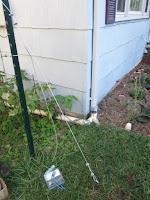I just realized this week that, in my haste to fit in my Recipe of the Month post for September, I completely overlooked Harvest Home, the Gardeners' Holiday that falls on the autumnal equinox. This is usually my favorite Gardeners' Holiday of the year, a celebration of the full abundance of the fall garden, and I feel a bit embarrassed about missing it.
So, to make up for it, I'm offering up a belated celebration of one particular crop that
There's just one problem with this bounty of berries: it really weighs down the canes. By September, the tallest ones had reached a height of over five feet, and their tips were reaching well past the top of the raspberry trellis we'd built to hold them up. The weight of the berries on these long canes bent them down over the top of the upper cable, and the sagging canes overlapped each other in a tangled thatch that it was really hard to sift through to extract the berries. Meanwhile, some of the shorter canes had bent downward under the lower of the two cables, sagging almost to the ground. In short, the trellis just wasn't doing its intended job of keeping the canes upright and easy to harvest from anymore.
So, at some point, I suggested to Brian that we fix this by adding a third line of cable to the trellis. If we moved the upper cable to the very top of the post, it would hold up the tallest canes, and a third line added below the current bottom one would hold up the low-hanging fruit. Brian agreed, but added that we'd have to fix another problem as well: finding a way to keep the lines taut. Under their burden of berries, the canes were pushing heavily down on the cables, pulling the two support poles inward toward each other. This, in turn, had caused the lines to go slack, so they weren't keeping the canes upright like they should. So, to make the trellis effective, we'd need to add some more lines to the posts to pull them outward, countering the inward pull of the heavy, berry-laden canes.
Fortunately, we still had two of the anchor stakes we'd bought to stake our plum tree after Tropical Storm Isaias. Brian figured if we attached a length of cable to the top of each metal pole, then ran a cable from there to the ground, pulling outward from the trellis, it would counter the inward pull on the line. We didn't have quite enough leftover cable to do this and also add another line to the trellis itself, so we invested $12 in another roll of cable and some hardware, and we were ready to tackle the project.



The line between the tops of the posts still wasn't quite taut at that point, but he was able to tighten it by adjusting the turnbuckle we'd presciently installed at the far end. Once it was taut, we carefully fed the tallest raspberry canes under it, detangling them as we went, to lift them up and out of the way while we worked on the middle line. Just this one step made a big difference in sorting out the thicket and making the berries more accessible.
At this point, we ran into a new problem: the middle line was exerting 
We then repeated the process of adjusting the canes, carefully feeding all the medium-height ones through so that they hung neatly over this middle line and only the short ones were left. To deal with those, we installed a new bottom cable about the same distance below the middle line as the top line was above it. Adding this new line from scratch was actually somewhat easier than adjusting the old ones. Brian started at the west end, putting a new eye bolt through the fence, running the cable through it, and securing it with a pair of clips. Then we unspooled the cable along the ground until it reached the other post and secured it there in a similar fashion, but with a new turnbuckle in between the eye bolt and the cable. Brian clipped off the excess wire and then tightened the turnbuckle, and the line snugged up, lifting the remaining short raspberry canes off the ground and holding them neatly in place.
It took us a few hours altogether (including a run to the Home Depot for more eye bolts when we realized the ones we'd picked up the first time were too big), but the new trellis makes a big difference to the raspberry patch. It's much easier both to see the berries, so we can tell at a glance which ones are ripe, and to reach them without getting scratched in the process. I think the time and money we invested in it will definitely pay for itself in the form of a more accessible berry harvest.






No comments:
Post a Comment